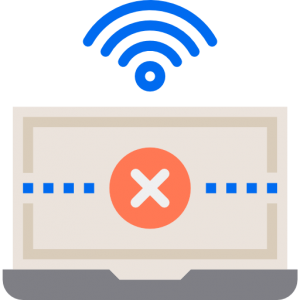Computer Not Connected To Internet
In today’s digital landscape, the internet has become an indispensable tool, connecting us to a vast realm of information, communication, and opportunities. However, there are times when our trusty computer keeps dropping internet connection. It’s a situation that can leave us feeling frustrated and bewildered, but fear not – this blog is your compass through the labyrinth of computer slow internet challenges. We will delve into the common reasons behind a computer not connected to internet issue, exploring troubleshooting steps & solutions to help you regain your online access. So, let’s embark on this guide, armed with knowledge & determination, to get your computer back online and keep you seamlessly connected to the digital world.
Why Computer Keeps Dropping Internet Connection:
A computer keeps dropping internet connection can be a vexing issue for users, and it can stem from various causes. Understanding why computer says no internet connection is crucial for diagnosing and resolving the problem. Below, we will explore some common reasons for why your computer not connected to internet:
-
Wireless Interference
Wireless networks operate on specific radio frequencies, and if there are many other electronic devices nearby using the same frequencies, interference can occur. This interference might lead to sporadic disconnections, causing computer says no internet connection.
-
Router Overload
Routers have limitations regarding the number of devices they can handle simultaneously. If you have many devices connected to your network or are engaging in bandwidth-intensive activities, it can overwhelm the router, causing intermittent dropouts or computer keeps dropping internet connection.
-
Outdated Hardware or Software
Both your computer’s hardware and software can contribute to connectivity issues. Outdated network drivers or operating systems may not be optimized to work seamlessly with your router, leading to computer connected but no internet.
-
Network Congestion
During peak usage hours, your internet service provider’s network may become congested. This can result in computer says no internet connection, especially if you’re in a densely populated area with many users sharing the same infrastructure.
-
Physical Cable Issues
For wired connections, damaged or improperly connected Ethernet cables can lead to computer connected but no internet connectivity. Even minor cable damage can disrupt the flow of data.

-
ISP Problems
Sometimes, the issue isn’t within your control. Internet Service Providers (ISPs) can experience outages or technical problems that result in computer keeps dropping internet connection.
-
Router Configuration Errors
Incorrect router settings or misconfigurations can cause the issue of computer says no internet connection. This could include issues with DHCP (Dynamic Host Configuration Protocol) settings, port forwarding, or security settings.
-
External Factors
Environmental factors, such as severe weather, might have an impact on the quality of your internet connection. Rain, snow, or electrical storms can disrupt the signals between your device and your ISP’s equipment. Causing computer connected but no internet connection.
-
Network Attacks or Malware
Malicious software or cyberattacks can disrupt your internet connection by overwhelming your network or compromising your device’s security.
-
ISP Data Throttling
Some ISPs practice data throttling, which involves purposely slowing down or disconnecting particular types of internet traffic, like file sharing or streaming, during peak periods or in accordance with specific usage regulations.
Understanding these potential reasons for a computer keeps dropping internet connection is the first step in troubleshooting and finding an appropriate solution. Identifying the root reason can assist you in determining the best line of action to reestablish a stable and uninterrupted internet connection.
How To Fix Computer Slow Internet Issue:
Dealing with a computer keeps dropping internet connection can be a vexing experience, disrupting your work, online activities, and entertainment. However, by following a systematic troubleshooting process, you can often identify and fix the issue. Below, we’ll outline steps to help you resolve this frustrating problem:
-
Restart Your Computer
If your computer can’t connect to wifi, begin with the simplest solution – restart your computer. Sometimes, a quick reboot can refresh network settings and resolve temporary glitches.
-
Check Wi-Fi Signal Strength
If your computer won’t connect to internet, Check to see if your PC is within an acceptable distance of your Wi-Fi router. Weak signal strength can lead to computer says no internet connection. If possible, move closer to the router or consider using wired Ethernet connection for a more stable connection.
-
Restart Your Router
Just like your computer, your router can benefit from a reboot. If your computer won’t connect to internet, unplug power cable from your router, wait about 30 seconds, and then plug it back in. Give it a few minutes to restart and re-establish connections.
-
Update Network Drivers
Outdated or corrupt network drivers can cause computer slow internet issues. If your computer can’t connect to wifi, visit your computer manufacturer’s website or the network adapter manufacturer’s site to download and install the latest drivers for your network adapter.
-
Check for Interference
Nearby electronic devices such as cordless phones, microwave ovens, and Bluetooth devices can interfere with Wi-Fi signals. If your computer not connected to internet, ensure your computer is not placed near such devices and try changing your Wi-Fi channel to minimize interference.

-
Disable Power Management for the Network Adapter
Some computers have power-saving features that may disable or reduce the power to the network adapter, leading to disconnections. To disable this feature:
- Right-click on the Start menu, select “Device Manager.”
- Expand the “Network adapters” section, right-click your network adapter, and select “Properties.”
- Go to the “Power Management” tab and uncheck the option that says “Allow the computer to turn off this device to save power.”
-
Check for Malware and Viruses
Malware or viruses can disrupt your internet connection. Run a thorough antivirus and anti-malware scan on your computer to ensure it’s clean.
-
Change DNS Servers
Sometimes, using alternative DNS servers can improve internet connectivity. If your computer keeps dropping internet connection, try using Google’s public DNS servers (8.8.8.8 & 8.8.4.4) or OpenDNS servers (208.67.222.222 and 208.67.220.220).
-
Use a Wired Connection
If possible, consider connecting your computer to the router using Ethernet cable. Wired connections are often more stable than Wi-Fi connections and might assist you in determining whether the problem is particular to the wireless connection.
-
Update Operating System and Software
If your computer says no internet connection, ensure that your operating system is up to date with the latest updates and patches. Additionally, keep all software related to network drivers, security, and web browsers updated. Outdated software can cause compatibility issues with internet connectivity.
-
Review Router Settings
If your computer not connected to internet, access your router’s settings through a web browser (usually by entering its IP address) and review the configuration. Look for settings related to wireless security, channel selection, and QoS (Quality of Service). Make adjustments as needed to optimize performance and stability.
-
Check for Background Applications and Updates
Some background applications and downloads, such as software updates or cloud backups, can consume significant bandwidth and lead to internet drops. Monitor your computer for such activities and schedule them during off-peak hours to minimize disruption.
-
Consider Hardware Upgrades
If you’ve exhausted all software-based solutions and continue to experience frequent disconnects, it may be time to consider hardware upgrades. This could involve replacing the network adapter or, in extreme cases, upgrading your computer to a newer model with improved hardware components.
By following these steps and being patient in your troubleshooting process, you can often identify and resolve the issue causing your computer keeps dropping internet connection. Remember that technology can be complex, but with persistence and a methodical approach, you can enjoy a more stable and uninterrupted online experience.
Conclusion:
In this blog, we’ve ventured through the often perplexing landscape of a computer not connected to internet. We’ve explored the various factors that can contribute to this issue, ranging from hardware glitches to software quirks and network hiccups. Armed with a systematic approach to troubleshooting, you can tackle these challenges head-on and restore your computer’s connection to the vast virtual realm. Remember, the solutions presented here are designed to guide you towards resolving common connectivity problems. Each situation can be unique, and sometimes, it may take a combination of steps to pinpoint and address the underlying issue. Patience and persistence are your allies in this endeavor. To know more about our support services, you can navigate to our website’s Homepage.
